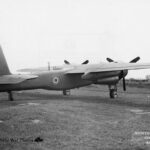Monitor wing
Monitor TT Mk II Prototype NP407
Monitor TT MK II
Monitor TT Mk II Prototype Target Tug
Monitor NP407
Monitor Mk II NP408
Monitor Mk II NP407
Monitor fuselage
Monitor TT MK II NP422 July 1946
Monitor TT Mk II NP406 in flight
Monitor NP407 in flight
Target tug Miles Monitor NP407 1945
Monitor NP407 in flight
Monitor NP407 in flight
Miles Monitor NP407 1945
Monitor NP407 1945
Miles Monitor NF900 1944
Target tug Miles Monitor NF900 1944
Miles Monitor
Flight on one engine
Monitor front
Monitor 1945
Monitor 1945
Miles Monitor 1945
Miles Monitor 1945
Miles Monitors 1947
Monitor was designed to Specification Q.9/42 to meet requirements for a high-speed target-tug which would have a towing speed of not less than 300 mph (480 km/h) and an endurance of 3-4 hours. The prototype TT Mk I first flew on April 5, 1944. and proved to be eminently satisfactory, the maximum speed being 360 mph (576 km/h). As naval requirements for such an aeroplane, and particularly one which could simulate dive-bombing attacks on ships, were urgent, the R.A.F. relinquished its claim to the Monitor, which was then put into production for the Royal Navy as TT Mk II, with certain modifications, including hydraulically-operated dive-brakes, to suit it to its new duties. The Mk II is intended primarily for high-speed Fleet targettowing duties. It can tow sleeve and flag targets as well as special winged targets of 16 and 32 ft. span. A 10 hp hydraulic winch is capable of handling all types of targets with 6,000 ft. of tow ing cable at speeds of over 300 m.p.h. Stowage for spare targets is provided internally and targets can be changed in flight. Winged targets are towed off the ground at the end of a 250 ft. cable, the cable being paid out in the air to anything up to 6,000 ft. according to the type of practice. Cameras are located in the nose and in the midship cupola for marking Fleet gunnery practices and Radar height-checking equipment is used to determine the accurate heights which are necessary in analysing such practices. The Monitor is of mixed construction with an all-wood onepiece wing and metal fuselage. To speed up design and production it xVas originally stipulated that the Monitor should use a standard Beaufighter wing and landing-gear but owing to the increased use of the Beaufighter this decision was abandoned and a new all-wood wing was designed for the aircraft. The Beaufighter landing-gear was, however, standardised. The power-plant consists of two 1,750 hp Wright R-2600-31 14-cylinder radial air-cooled engines driving Hamilton Standard Hydromatic airscrews. Hydraulic power for the landing-gear, flaps, dive brakes and towing winch is supplied by pumps driven, off the starboard engine. Wing fuel tanks have a capacity of 480 gallons. The crew of two consists of pilot and observer/target-operator. Target operation has been simplified so that the operator merely places a target on an endless belt and, after connecting the target halyard to the towing cable, pulls a lever. By this means the target is automatically ejected from an aperture in the underside of the fuselage, thereby minimising the amount of draught and discomfort usually associated with the opening of doors while flying.

























